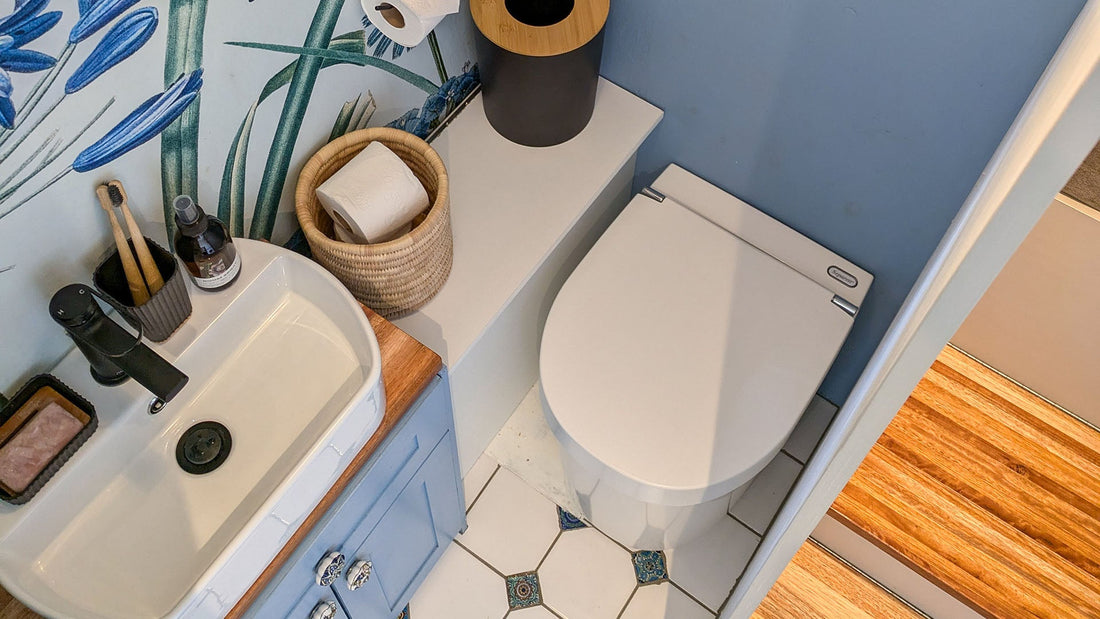
What is a Composting Toilet? A Complete Guide to Eco-Friendly Toilets
Share
Introduction
Composting toilets have become a popular solution for those looking to reduce their environmental footprint while managing waste in an eco-friendly way. Unlike traditional flush toilets, composting toilets don’t rely on water or sewage systems, making them ideal for off-grid living, RVs, cabins, and even eco-conscious homes. These toilets use natural processes to turn human waste into compost, significantly reducing water consumption and environmental impact.
In this guide, we’ll explain what composting toilets are, how they work, and why they’re one of the most sustainable waste management systems available today.

How Do Composting Toilets Work?
Composting toilets operate by separating liquids and solids and using natural decomposition to break down waste. The process is designed to eliminate pathogens (germs etc) and reduce waste volume over time, turning it into safe compost.
- Separation of Liquids and Solids: Most composting toilets, such as those from Separett, feature a urine diversion system. This system directs liquids into a separate container or drainage system while solid waste is deposited into a composting chamber.
- Decomposition and Composting: The solid waste begins to decompose with the help of aerobic bacteria, which break down organic material into compost. Proper ventilation and drainage ensure that the waste is oxygenated, which minimizes odors and accelerates the composting process.
- Urine Diversion: By separating liquids from solids, composting toilets greatly reduce odors. Urine, which is sterile when separated, can be disposed of or reused safely, for example as a plant fertilizer, depending on the setup.
- Ventilation and Odor Control: Most composting toilets use a fan or ventilation system to keep the composting chamber dry and ensure air circulation, further reducing odors. With proper maintenance, composting toilets can remain odor-free.

Advantages of Composting Toilets
1. Water Conservation
One of the biggest benefits of composting toilets is their ability to save water. Traditional flush toilets use up to seven gallons of water per flush, whereas composting toilets require none. This makes them ideal for off-grid homes, cabins, RVs, and places where water conservation is crucial.
2. Odor-Free Operation
Contrary to popular belief, composting toilets are designed to be odor-free when properly maintained. Systems that separate liquids and solids, like the ones offered by Separett, prevent the buildup of odor-causing bacteria. Additionally, ventilation systems help keep the composting chamber dry and odorless.
3. Low Maintenance
With regular care, composting toilets require minimal maintenance. Emptying the compost chamber typically happens only a few times a year, depending on the size of the household and the model of the toilet. By managing liquids and solids separately and using ventilation, you can ensure the system works efficiently.
4. Eco-Friendly Waste Management
Composting toilets allow you to return waste to the environment in a safe and beneficial way. Once fully decomposed, the waste can be used as compost, closing the loop on your waste management process. This minimizes your impact on the environment and promotes sustainability.

Types of Composting Toilets
There are two main types of composting toilets: self-contained systems and central composting systems.
1. Self-Contained Composting Toilets
In a self-contained system, all of the composting processes occur within the unit itself. These toilets are compact and easy to install, making them ideal for small spaces such as RVs, tiny homes, or cabins. Self-contained models often have a separate container for liquid waste and require periodic emptying of the composting bin. They are a great option for mobile setups or areas without space for a central system.
2. Central Composting Systems
Central composting systems involve a separate composting chamber, often located outside or beneath the house. Waste is directed from the toilet to the central composting unit, which is typically larger and can handle more capacity. These systems are often found in larger homes or multi-user environments and can process waste for longer periods before needing maintenance. While they require more space, central systems offer greater composting efficiency and less frequent emptying.

Conclusion
Composting toilets are an essential part of sustainable living. They conserve water, reduce the environmental impact of waste disposal, and provide an odor-free, low-maintenance solution for homes, cabins, and RVs. Whether you’re looking for a self-contained unit for a tiny home or a central composting system for a larger household, composting toilets can help you live more sustainably while turning waste into a valuable resource.
By choosing a composting toilet, you’re not only conserving water but also embracing a more eco-friendly lifestyle. Explore Separett’s range of composting toilets and find the perfect fit for your needs, whether you’re off-grid, on the road, or simply looking to make a positive environmental impact.
